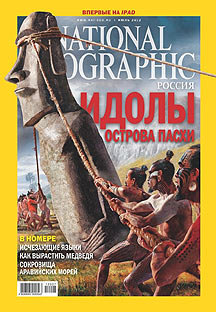National Geographic Russia in July

The July issue of National Geographic Russia focuses on the mysterious story of the giant idols of Easter Island that, according to local lore, “walked” 18 kilometers centuries ago. How did ancient peoples accomplish that task without the help of draft animals and wheeled vehicles? New hypotheses help scientists unravel the mystery.
Also in this issue:
Nursery school for bear cubs. Can a human rear a bear cub in captivity and, when it reaches maturity, release it into the wild prepared for every difficulty? Yes! In an isolated village in the Tver region, Russian scientists with long years of experience with brown bears have organized the Center for the Rescue and Rehabilitation of Orphaned Bear Cubs. They have managed to return 150 bears to the wild in recent years.
Endangered languages. Every two weeks, another spoken language somewhere on Earth disappears. By the start of the next century, approximately half of the world’s 7,000 spoken languages will have disappeared because the people speaking them prefer switching to English, Chinese or Spanish. What do we lose every time another language ceases to exist?
The precious sea. The waters of the Arabian Peninsula are rich in rare flora and fauna, and the region produces unique pearls that grace eminent collections. However, more treasures are mined from the sea depths than the ecosystem can replenish.


